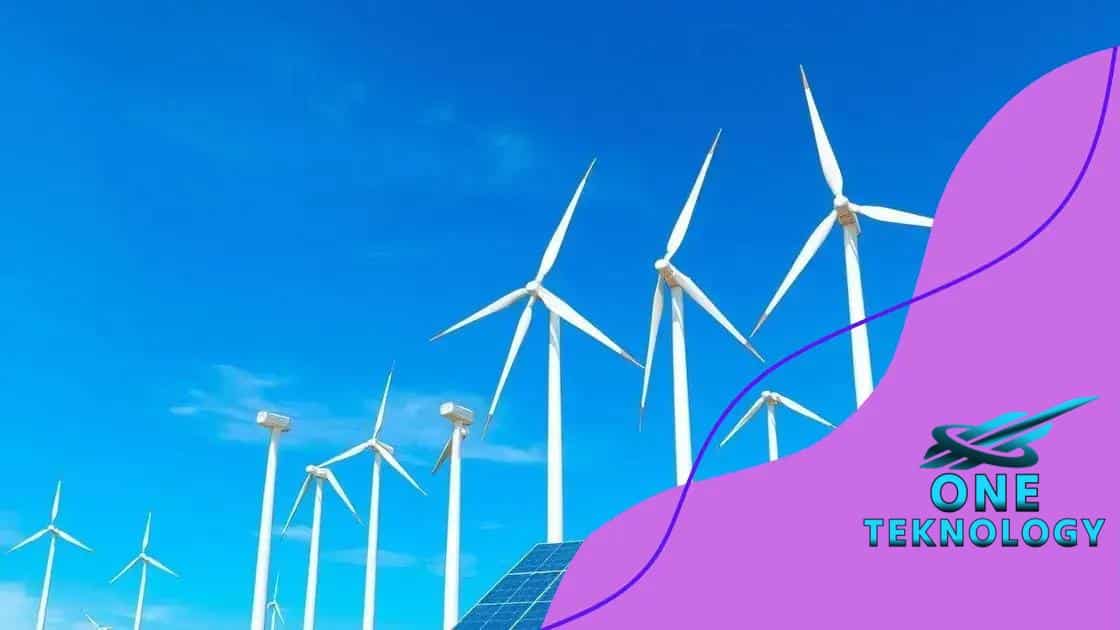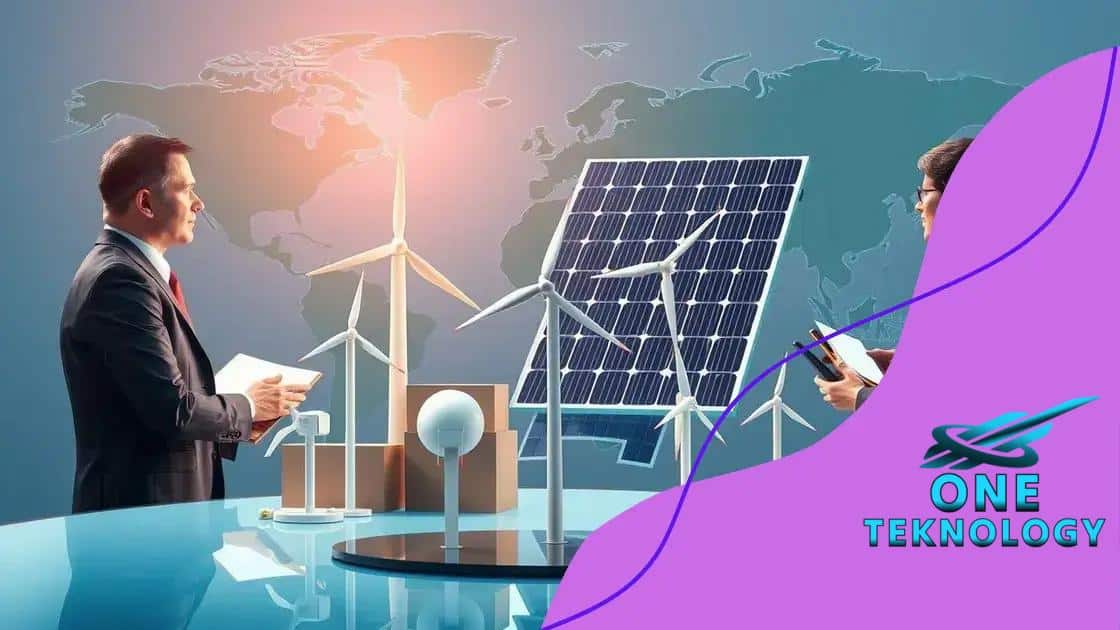Renewable energy policies and their impact on global markets

Renewable energy policies and their impact on global markets drive technological advancements and create opportunities, while presenting challenges in adoption and requiring collaboration among stakeholders to ensure sustainable growth.
Renewable energy policies and their impact on global markets are reshaping how we think about energy. Have you ever wondered what drives these changes?
Understanding renewable energy policies
Understanding renewable energy policies is crucial for grasping how countries deal with energy challenges. These policies not only promote cleaner energy but also reshape economic landscapes.
At the heart of these initiatives lies a commitment to sustainability. Countries are setting ambitious goals to reduce greenhouse gas emissions and increase the share of renewable energy in their energy mix. By doing so, they aim to protect the environment while fostering economic growth.
Key Elements of Renewable Energy Policies
Several key components define these policies:
- Incentives: Governments often provide financial support or tax breaks to encourage businesses and individuals to invest in renewable technologies.
- Regulations: There are laws aimed at reducing carbon emissions, guiding the energy sector towards greater sustainability.
- Research and Development: Funding for innovation is crucial to enhance the efficiency and affordability of renewable energy sources.
- International Cooperation: Many countries collaborate to share technology and strategies that can accelerate the transition to cleaner energy.
The impact of these policies is evident. Many nations are seeing a rise in investments in solar and wind energy. This shift not only helps combat climate change but also creates job opportunities in emerging green industries. As more countries adopt aggressive renewable energy policies, the global market becomes increasingly interconnected.
All these elements work together, creating a robust framework that supports the growth of renewable energy. As economies shift focus towards sustainability, understanding these policies can provide valuable insights into future market trends.
With the ongoing changes, it’s essential to stay informed on how renewable energy policies affect global markets. Engaging with this topic can help individuals and businesses anticipate changes and adapt to new opportunities.
Key players in global renewable energy
When discussing key players in global renewable energy, it’s essential to identify the organizations and governments pushing the industry forward. These entities play a crucial role in shaping policies and driving innovation.
Firstly, government bodies are often at the forefront. They create regulations and incentives that promote the adoption of renewable energy technologies. Many countries have established national agencies to oversee energy initiatives, which help ensure that renewable projects align with economic and environmental goals.
Major Companies Leading the Way
Several corporations have emerged as leaders in the renewable sector:
- Ørsted: This Danish company has pivoted from fossil fuels to wind energy and has become a top player in offshore wind projects.
- NextEra Energy: Based in the USA, they are one of the largest producers of wind and solar energy in North America.
- Siemens Gamesa: A global leader in wind turbine manufacturing, they enable many countries to harness wind energy effectively.
- First Solar: This American company specializes in manufacturing solar panels and has a significant global footprint in solar projects.
In addition to corporations, environmental organizations also drive change. Groups like the World Wildlife Fund and Greenpeace advocate for policies that support renewable energy adoption. Their campaigns raise awareness and encourage public support for sustainable practices.
Investors are also crucial. They provide the capital needed to fund innovative renewable energy projects. Venture capitalists and institutional investors are increasingly looking to support companies that focus on clean energy. This influx of funding has propelled many startups into the market, fostering a spirit of innovation and competition.
These key players collaborate through partnerships and alliances to address common challenges. By working together, governments, businesses, and environmental organizations can accelerate the transition to a global economy that relies less on fossil fuels and more on sustainable energy sources.
Impact on international trade dynamics

The impact of renewable energy policies on international trade dynamics is profound. As countries shift towards greener energy sources, they disrupt traditional energy markets and create new opportunities for trade.
Firstly, the rise of renewables has led to a greater demand for clean technologies and resources. Countries that produce solar panels, wind turbines, and batteries for electric vehicles are seeing increased exports. This has allowed nations like China to dominate the manufacturing sector for renewable energy technology.
Key Changes in Trade Patterns
Several key changes are shaping the landscape:
- Emerging Markets: Countries rich in natural resources for renewable energy, like lithium and cobalt, are becoming critical players in global supply chains.
- New Trade Agreements: Nations are forming partnerships focused on exchanging renewable energy technology and expertise, leading to innovative solutions.
- Reduced Dependence on Fossil Fuels: As countries invest in renewable energy, the demand for fossil fuels may decrease, altering trade relationships.
- Increased Investment: Investments in renewable sectors encourage the flow of capital across borders, affecting currency exchange and trade balances.
This shift impacts both developed and developing economies. Countries that adapt quickly can position themselves as leaders in the emerging green economy. Conversely, those that fail to innovate risk being left behind.
The transition to renewables also raises questions about energy security. Nations previously reliant on fossil fuel imports must now explore how to ensure their energy needs are met sustainably. This involves diversifying sources of energy and investing in local renewable projects.
As trade dynamics evolve, it’s essential to monitor how international relations change in response to the growing importance of renewable energy. The interplay between trade policies and energy initiatives is vital for understanding the global market landscape.
Challenges and opportunities in adoption
The adoption of renewable energy presents both challenges and opportunities for countries and companies worldwide. Understanding these factors is crucial for effective implementation and growth in this sector.
One significant challenge is the initial cost of transitioning to renewable energy sources. Investments in infrastructure, technology, and training can be substantial. For many nations, especially developing ones, securing funding can impede progress. Additionally, the need for a skilled workforce to install and maintain renewable systems requires education and training investments.
Key Challenges to Overcome
Some key challenges to the adoption include:
- Infrastructure Limitations: Aging energy grids may not support the integration of renewable sources without significant upgrades.
- Regulatory Barriers: Inconsistent policies and regulations can create uncertainties for investors and businesses, hindering growth.
- Resource Dependency: Countries that heavily rely on fossil fuels for their economy may face resistance to transition.
- Technology Gaps: In some regions, access to the latest technologies required for renewable energy deployment is limited.
Despite these challenges, there are numerous opportunities on the horizon. The shift towards renewable energy can drive innovation and economic growth. Companies that embrace these changes can benefit from new markets and increased demand for clean energy solutions.
Furthermore, governments are beginning to recognize the economic potential of renewable energy. This has led to policies aimed at boosting investment in green technologies. A supportive regulatory environment can encourage businesses to explore renewable energy options.
Investments in renewable energy not only create jobs in installation and maintenance but also lead to advancements in technology. Research and development in battery storage, solar panels, and wind turbines are continually evolving, resulting in more efficient and cost-effective solutions.
The global push toward sustainability is also motivating collaboration among nations. Countries are sharing best practices and technology to enhance their renewable energy capabilities. This creates a community focused on tackling climate change and driving economic sustainability.
Future trends in the renewable market
Future trends in the renewable market indicate exciting changes that could transform energy production globally. As technology advances, the landscape for renewable energy is rapidly evolving.
One significant trend is the increasing efficiency of renewable technologies. Innovations in solar panels and wind turbines are making these energy sources more productive and cost-effective. As research continues, we may see breakthroughs that make renewables even more competitive against fossil fuels.
Emerging Technologies to Watch
Several technologies are expected to shape the future of the renewable market:
- Energy Storage Solutions: Advanced batteries are being developed to store solar and wind energy, allowing for a steady energy supply even when the sun isn’t shining or the wind isn’t blowing.
- Smart Grids: The integration of smart technology into energy grids helps distribute renewable energy more efficiently, managing energy supply and demand dynamically.
- Hydrogen Energy: Green hydrogen, produced using renewable energy, is gaining attention as a clean fuel alternative for transportation and industry.
- Offshore Wind Farms: Development of wind farms in ocean areas maximizes wind potential while reducing land use conflict.
Additionally, consumer behavior is shifting towards sustainability. More individuals are interested in using renewable energy in their homes. This demand can drive local governments to support community solar projects and incentives for renewable installations.
Global policies are also becoming more favorable for renewables. Governments are setting more ambitious targets for reducing greenhouse gas emissions, which creates a healthy environment for renewable industries. Countries are increasingly participating in international agreements aiming at sustainable energy practices.
Investment in renewables is on the rise as well. Financial institutions are recognizing the long-term benefits of funding clean energy projects. Venture capitalists are actively seeking startups that innovate in the space, leading to a surge of new ideas and technologies entering the market.
As we look to the future, it’s clear that the dynamics of the renewable energy market will continue to evolve. Staying informed about these trends will be vital for businesses and individuals aiming to harness the power of clean energy.
In conclusion, the renewable energy landscape is changing rapidly, opening up new opportunities and challenges. As technology improves, more countries are adopting renewable energy solutions, which not only help the environment but also boost economies. Key players, from governments to businesses, play a critical role in this transition. Staying informed about future trends is essential for anyone looking to participate in or benefit from this thriving sector. The future is bright for renewable energy!
FAQ – Frequently Asked Questions about Renewable Energy
What are the main benefits of renewable energy?
Renewable energy reduces greenhouse gas emissions, enhances energy security, and creates job opportunities in new industries.
What challenges do countries face in adopting renewable energy?
Challenges include high initial costs, the need for infrastructure improvements, and regulatory barriers.
How do emerging technologies impact the renewable energy market?
Emerging technologies, like energy storage and smart grids, improve efficiency and reliability, enabling more widespread use of renewable energy.
How can individuals contribute to renewable energy efforts?
Individuals can support renewable energy by choosing green energy options, advocating for policies, and investing in energy-efficient solutions at home.






